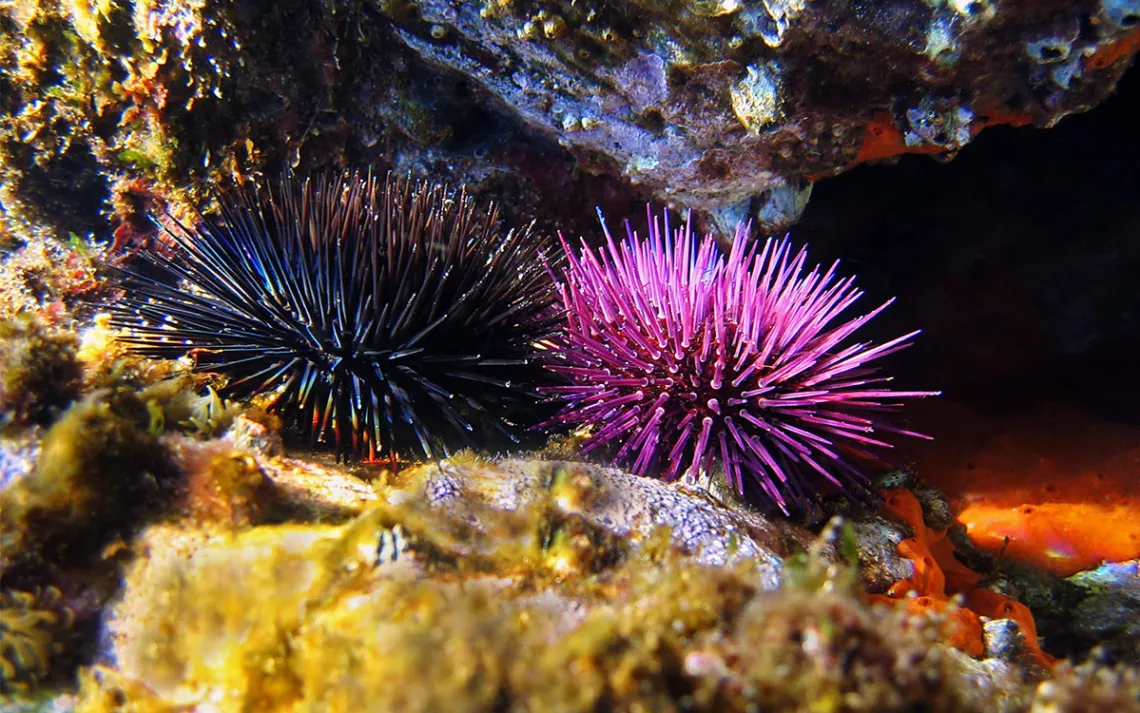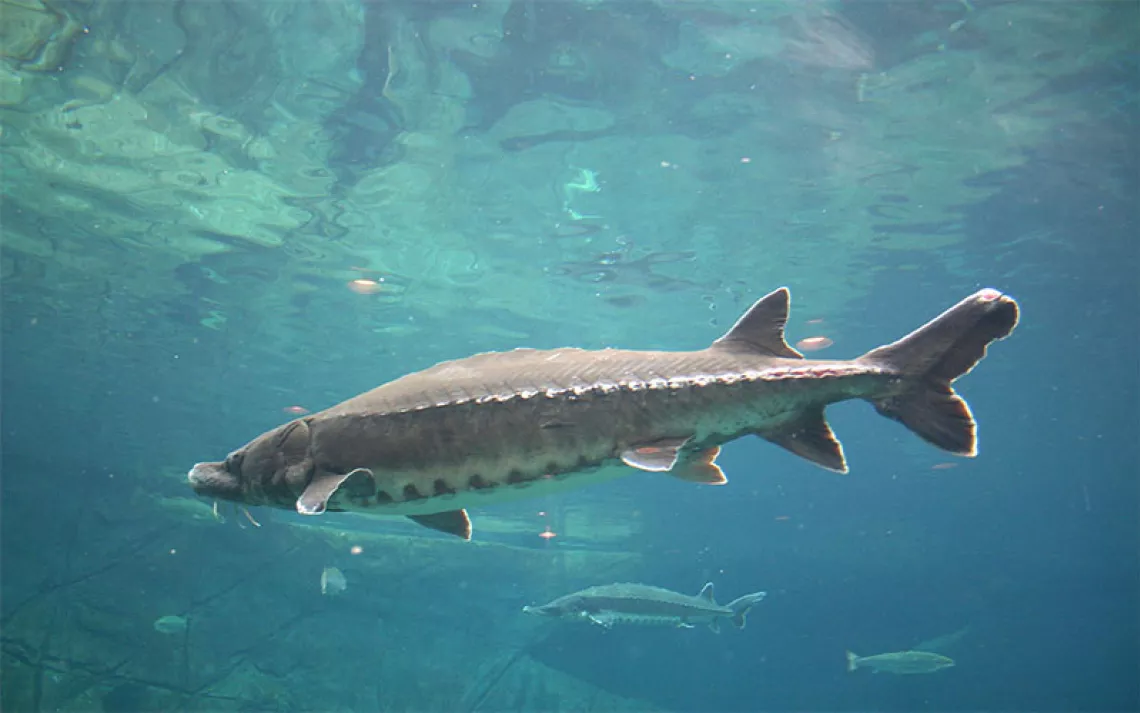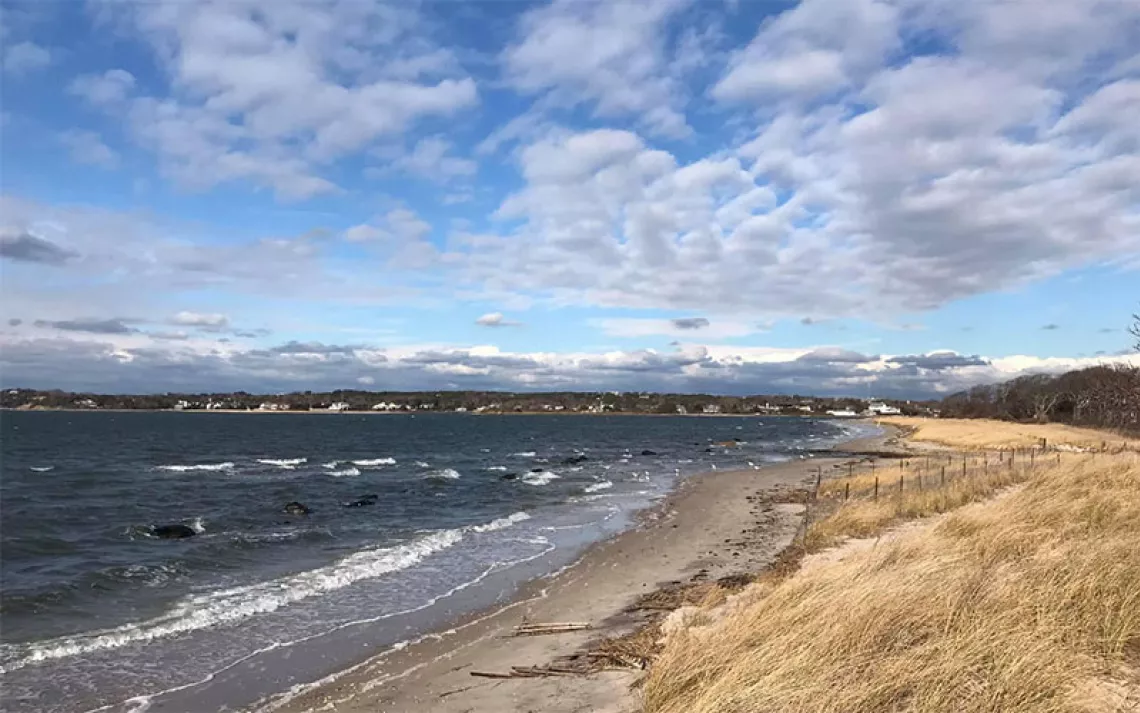Can Humanity Save Kelp by Eating the Problem Away?
How aquaculture for urchins could help restore California’s kelp ecosystems

Purple and black sea urchins. | Photo byDamocean/iStock
When Sheila Semans, the executive director at the Noyo Center for Marine Science in Fort Bragg, envisioned the center a decade ago, she hoped to celebrate the thriving ocean environment at the Northern California town’s doorstep. But today, the small nonprofit’s educational programming is driven by the need to repair an ecosystem in crisis.
The north coast’s seafloor was once canopied by large strands of bull kelp, a keystone species that acts like a redwood underwater, upholding many forms of life, sequestering carbon, and regulating the ocean’s pH. Now, purple urchins have overrun the ecosystem at a whopping 100 times their average numbers, and kelp—which urchin eat—declined by around 96 percent between 2016 and 2020. A confluence of factors have led to this: the extirpation of sea otters, a reduction in sunflower sea star populations, and an extreme marine heat wave. With the ability to subsist on next to no food for years and the loss of both of their natural predators, urchins continue to multiply and gobble kelp almost as soon as any grows.
Aquaculture for the overpopulated species is the latest in a grab-bag of solutions that scientists, international companies, and nonprofits alike hope could rebalance the out-of-whack ecosystem. But it remains to be seen whether an approach fraught with permitting challenges and a reliance on luxury consumers could help a wild ecosystem rebound.
“It gives us time while we work out a plan to reset and restore the ecosystem by reestablishing that primary predator of the purple urchin—the sunflower sea star—and doing active outplanting of kelp forest,” said Frank Hurd, who specializes in California’s fisheries with the Nature Conservancy. “Fishing can be a pretty powerful resource for really changing the dynamic of a population.”
A study last year found that kelp grew back more successfully when urchins were removed down to less than two per square meter—what’s missing is an incentive to do so. Aquaculture would leverage that lucrative commercial market to support urgent environmental needs. Of course, the rearing of aquatic animals in captivity has well-documented pitfalls. Feed ingredients can pass on contaminants that impede food safety; effluents from shrimp farms can have detrimental impacts on the surrounding environment; and while sometimes touted as a solution to overfishing, finfish aquaculture has run into trouble with escaped fish and high risk of disease.
Urchin ranching is a newer process and falls into a low-trophic, or lower on the food chain, category that some economists and researchers believe could be the future of sustainable aquaculture. But making it work is complicated—unlike other kinds of aquaculture, urchin ranching does not involve hatching new urchins. Instead, urchins are taken from the ocean, placed in raceways (manmade channels that allow water to flow through), and fattened up enough to produce quality uni, the edible gonads of the urchin, in around six to 10 weeks. “You’re literally eating, or trying to eat, a problem away,” explained Harm Kampen, the director of Research and Development for Urchinomics, a company based in the Netherlands that aims to facilitate exactly that.
Urchinomics has implemented land-based ranching facilities across multiple continents to provide a pathway for human predators to enjoy overpopulated shellfish. They remove overgrazing urchins to help kelp populations rebound, feed the urchins in aquaculture facilities to produce viable uni, and sell those ranched urchins wholesale to restaurants. Their largest facility boasts 200 raceways, and they’re hoping to expand. By contrast, a small-scale state-funded aquaculture pilot project in Fort Bragg’s Noyo Harbor would be more grassroots. The Noyo Center hopes to utilize water from the Noyo River and explore multitrophic cascading aquaculture in a container they could build themselves, using seaweed to help polish—or filter—the water and mimic the interspecies relationships of a natural food web.
Semans also hopes to bring school groups to tide pools on free fishing days to collect overpopulated purple urchins and host tasting events to introduce tourists and locals to the shellfish. Part of the goal is working out the kinks to show other community members what’s possible. But even this “bridge to natural recovery,” as Semans calls it, has hurdles. At a larger scale, permitting a new site in California is virtually impossible due to fees in the hundreds of thousands and multiagency regulations, meaning the best bet is using prior aquaculture facilities. Dan Swezey, a project scientist at Bodega Marine Laboratory out of the University of California, Davis, hopes legislative intervention and long-term investment could make pursuing these novel climate solutions more practical in the future.
“I think that we're in a good moment in that some funding is coming for us to get one foot out the door,” he said. “But there's really 20 feet to go.”
For his part, Kampen is skeptical of multitrophic aquaculture systems like the small project the Noyo Center hopes to implement in Fort Bragg. He feels it’s harder to achieve commercial viability at a larger scale when trying to create a flow-through system that benefits multiple species. Because kelp restoration has socioeconomic implications for many communities, those financial considerations are important. In Northern California, the commercial red urchin industry has suffered due to kelp loss and overpopulated purples, for which there’s no market.
Fort Bragg urchin diver Grant Downie is a veritable ambassador for purple urchins, selling shooters off his boat and describing the “unfathomable” flavor profile as “creamier” and “sweeter” than typical uni. “The biggest benefit to the urchin industry itself that ranching brings is market demand,” he said, adding, “With ranching, you would always have a good urchin to offer, so you're not going to lose your markets to other countries’ urchin.”
At Bodega Marine Lab, Swezey and fellow researchers are conducting their own urchin ranching trials alongside the Nature Conservancy, with the goal of supporting working harbors and fishing communities. (Downie collects urchins for these trials). They hope to open-source this aquaculture technology and offer scalable, locally available options for ecosystem repair. “Because there are literally billions and billions of these urchins, the more we can share and the more communities have access to these approaches, the faster we'll be able to make a dent,” Swezey said.
In addition to studying marine ecosystem shifts and breeding abalone, the lab tests factors that produce uni worth restaurateurs’ money. Next summer, Swezey’s lab will cross-test much of what they’ve discovered to determine optimal temperatures, lighting, and different types of food for industrial use. He’s even exploring creating feed from agricultural waste, like grape skins, that could offer an abundant local source in California.
Researchers agree that ranching presents just one piece of a larger puzzle of climate solutions to retain kelp ecosystems. An outplanting technique called green gravel is another approach, involving seeding lab-grown kelp plants along the ocean floor. Meanwhile, scientists at Friday Harbor Laboratory in Washington’s Salish Sea are working to raise sunflower sea stars in captivity, with the goal of preventing extinction and eventually bolstering the urchin predator’s presence in the ecosystem. In a more out-of-the-box solution, the Department of Fish and Wildlife is exploring the possibility of sea otter reintroduction. And at a couple nearshore locations in California, recreational divers gather once a month to smash urchins.
Taken together, these efforts offer hope for kelp forests beyond the status quo of precipitous decline. But they all demand time—and money. “I would never go so far as to say [urchin ranching] is the answer to our problems,” Semans said. “But it's one of the few things that I think could have a measurable impact at this point and be sustainable.”
 The Magazine of The Sierra Club
The Magazine of The Sierra Club



